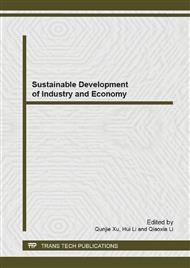[1]
National Bureau of Statistics of China: China statistical yearbook, Beijing 2010. In Chinese.
Google Scholar
[2]
L. B. Yang, S. Y. Zeng, Y. P. Ju, M. He, J. N. Chen: Water and Wastewater Engineering, Vol. 34(2008), pp.42-54. In Chinese.
Google Scholar
[3]
X. Q. Guo, H. D. Lin, W. L. Li: Industrial water and wastewater, Vol. 37(2006), pp.58-60, 70. In Chinese.
Google Scholar
[4]
National Engineering Center of Wastewater: China Environmental Protection Industry, Vol. 1(2003), pp.32-35.
Google Scholar
[5]
L .X. Liu, B. P. Zhang, X. J. Lu, X. H. Wu, Y. Z. Ren: Information of China Construction (Water-Industry Market), Vol. 3(2008), pp.58-61. In Chinese.
Google Scholar
[6]
X. Gao, T. R. Long, J. S. Guo: Journal of Chongqing University (Natural Science Edition), Vol. 25(2002), pp.143-148. In Chinese.
Google Scholar
[7]
Water Pollution Control Federation: Operation of Wastewater Treatment Plants-Manual of Practice No. 11. Washington D C: Lancaster Press, (1976).
Google Scholar
[8]
H. H. Mcmillan, R. R. Rimkus, F C Neil: Journal (Water Pollution Control Federation), Vol. 53(1981), pp.155-161.
Google Scholar
[9]
S. A . Tassou: Applied Energy, Vol. 2(1988), pp.113-129.
Google Scholar
[10]
E. L. J. Rushbrook, D. A. Wilke: Journal (Water Pollution Control Federation), Vol. 52(1980), pp.2477-2483.
Google Scholar
[11]
B. Evans, P. Laughton: Water Science and Technology, Vol. 30(1994), pp.17-23.
Google Scholar
[12]
S. S. Yang: Building technical communications (Water and Wastewater), Vol. 6(1984), pp.15-19. In Chinese.
Google Scholar
[13]
G. M. Wesner, G. L. Culp, T. S. Lineck, D. J. Hinrichs: Energy conservation in municipal wastewater treatment (430/9-77-011). Washington DC: Office of Water Program Operations, USEPA, 1978. A. Jacobs: Water Sewage Works, (1977).
Google Scholar
[14]
Y. M. Lo, D. Cao, S. Argin-soysal, J. Wang, T. Hahm: Bioresource Technology, Vol. 96(2005), pp.687-698.
Google Scholar
[15]
H. K. Shon, S. Vigneswaran, I. S. Kim, J. Cho, H. H. Ngo: Journal of Membrane Science, Vol. 278(2006), pp.232-238.
Google Scholar
[16]
R. Rosal, A. Rodríguez, J. A. Perdigón-Melón, A. Petre, E. García-Calvo: Chemical Engineering Journal, Vol. 149(2009), pp.311-318.
DOI: 10.1016/j.cej.2008.11.019
Google Scholar
[17]
F. El-Gohary, A. Tawfik: Desalination, Vol. 249(2009), pp.1159-1164.
Google Scholar
[18]
X. J. Zhu, Z. Y. Zhou, T. Y. Gao: China Water and Wastewater, Vol. 13(1997), pp.11-13. In Chinese.
Google Scholar
[19]
P. R. Gogate, A. B. Pandit, Advances in Environmental Research, Vol. 8(2004), pp.501-551.
Google Scholar
[20]
P. Zhang, R. Hai, D. Zhou, Y. He, Z. Bai: Chinese Journal of Chemical Engineering, Vol. 19(2011), pp.881-890. In Chinese.
Google Scholar
[21]
S. Wang, J. Liu: Sichuan Nonferrous Metals, Vol. 3(2011), pp.59-64. In Chinese.
Google Scholar
[22]
J. Nouri, K. Naddafi, R. Nabizadeh, M. Jafarinia: Asian Journal of Water. Environment and Pollution, Vol. 4(2007), pp.145-149.
Google Scholar
[23]
X, Gao: Chongqing University, Vol. 2-3(2002), pp.31-33. In Chinese.
Google Scholar
[24]
X. H. Xu, Z. J. Li: Journal of Xinjiang University (Natural Science Edition), Vol. 20(2003), pp.109-112. In Chinese.
Google Scholar
[25]
F. J. Liu, F. S. Guo, H. Zeng, X. G. Wang, F. Qian: Industrial Safety and Environmental Protection, Vol. 33(2007), pp.32-34. In Chinese.
Google Scholar
[26]
L. Mei, P. Yang, S. Y. Shang: Chemical Industry, Vol. 33(2004), pp.282-285. In Chinese.
Google Scholar
[27]
J. Ma, L. P. Qiu: Environmental Engineering, Vol. 20(2002), pp.7-11. In Chinese.
Google Scholar
[28]
B. Zhang, Y. B. Nan, J. Sun: Environmental Science and Management, Vol. 34(2009), p.110–112. In Chinese.
Google Scholar
[29]
Z. W. Song, X. J. Bi, J. Cao: Chinese Journal of Ecology, Vol. 22(2003), p.74–78. In Chinese.
Google Scholar
[30]
Q. H. Zhang, W. J. Liang, X. S. Jia: 2010 China Environmental Science Society Annual Meeting Proceedings, Vol. 3(2010), pp.2878-2883. In Chinese.
Google Scholar


